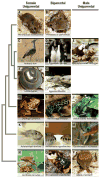Neural control of maternal and paternal behaviors
- PMID: 25124430
- PMCID: PMC4230532
- DOI: 10.1126/science.1253291
Neural control of maternal and paternal behaviors
Abstract
Parental care, including feeding and protection of young, is essential for the survival as well as mental and physical well-being of the offspring. A large variety of parental behaviors has been described across species and sexes, raising fascinating questions about how animals identify the young and how brain circuits drive and modulate parental displays in males and females. Recent studies have begun to uncover a striking antagonistic interplay between brain systems underlying parental care and infant-directed aggression in both males and females, as well as a large range of intrinsic and environmentally driven neural modulation and plasticity. Improved understanding of the neural control of parental interactions in animals should provide novel insights into the complex issue of human parental care in both health and disease.
Copyright © 2014, American Association for the Advancement of Science.
Figures





References
Publication types
MeSH terms
Grants and funding
LinkOut - more resources
Full Text Sources
Other Literature Sources
Medical

